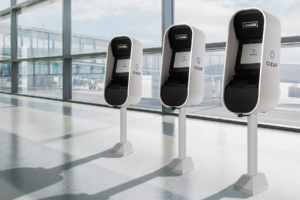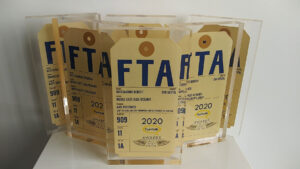Last edit by: serpens
What is EMV?
EMV is a standard for smart (or integrated-circuit, or chip) cards and the devices that can accept them. The standards are maintained by EMVCo and based on ISO 7816 (or ISO 14443 for contactless).
These cards come in two flavours: contact and contactless. Examples below:

----------------------------------------------------------
Notice the contactless
 indicator on the right-hand side (it looks like a sideways Wi-Fi symbol). It may also be found on the back of the card (for example, on the back of the new Costco credit card).
indicator on the right-hand side (it looks like a sideways Wi-Fi symbol). It may also be found on the back of the card (for example, on the back of the new Costco credit card).Where can I get a chip card?
Hawaiian717 operates a website with crowd-sourced information about various cards. You can adjust the search parameters to see cards with contactless, have PIN-primary authentication, etc.
Which businesses accept chip cards?
tmiw operates a website, also primarily crowd-sourced, that tracks chip-enabled merchants on a map. You can see if a merchant supports PIN, contactless, Quick Chip, et al.
Why doesn't my chip card ask for a PIN?
This is likely because you have a signature-preferring card. At this time, PIN-preferring cards issued in the US are rare. Not many financial institutions offer them; most of them instead provide Chip-and-Signature cards, which are programmed to prefer signature over PIN, if the card supports PIN at all.
What is the difference between Chip-and-Signature and Chip-and-PIN?
To the cardholder, the only major difference is how they authenticate themselves at the point of sale. The cardholder inserts their card as normal; instead of signing a screen or receipt, they will be asked to enter their PIN on the keypad.
[spoiler]
A few financial institutions issue some form of Chip-and-PIN credit cards or prepaid cards. Prepaid EMV cards however are not recommended due to junk fees.
Why no PIN? (cont.)
American debit cards are unique because they are psuedo-PIN-preferring cards. which may work at many automated kiosks. However, bear in mind the word may is used above is a context where there is no absolute certainty of success for certain environments such as automated kiosks due to different natures of offline and online transactions.
What is the difference between Chip-and-Signature and Chip-and-PIN? (cont.)
Most cards issued in the US are programmed to prefer signature, so save very few instances, they will prompt for a signature (unless the merchant sets a signature waiver). A PIN may be necessary in countries with mostly PIN-preferring cards when using unattended terminals (such as pay-at-the-pump or mass transit). If the card has a PIN for backup verification or ATMs, then that PIN should work. Otherwise, the card will be rejected. If the card is rejected, then either a.) the transaction must be performed by an attendant or b.) an alternative payment method will be required.
Some credit union issued credit cards will have this CVM (Cardholder Verification Method) as secondary if Chip-and-Signature cannot be done. Chip-and-PIN is the more prevalent method of authentication used outside the US, especially in transaction environments where no human interaction is needed (i.e. automated gas pumps, toll roads, train kiosks, etc.).
One chip can hold a lot more data, therefore it is capable of doing multiple verification methods. That's one of the great things about EMV over the mag-stripe which can hold very little data.
I want to know for sure what my EMV chip does. Is there anyway I can test out my own EMV card to see what the CVM list is?
alexmt has written up a nice step-by-step procedure on Post #3615.
If most of the EMV cards in the US is the Chip-and-Signature type, doesn't that mean it's still useless abroad?
Depends if you see it as glass half empty or glass half full. See Post #3 for further details on how Chip-and-Signature has worked both successfully and unsuccessfully depending on the merchant transaction environment and use your best judgment whether which one is right for you.
I don't want a chip in my card. I heard horror stories all over the media saying hackers can steal my credit card info from a mile away.
There are two types of chips. One is contactless and the other is contact. Cards can be either one or the other, or both.
In the Google Docs spreadsheet, the cards that are capable of contactless payments are listed seperately under the "RFID or NFC contactless chip" column. If it says yes, then that means it has the ability to do contactless payments. If it says no, it doesn't have that feature.
The one that the media has overhyped about hackers "stealing your information wirelessly" was the contactless type like this:
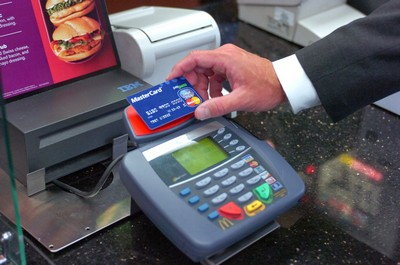
You are worried about this happening, right?
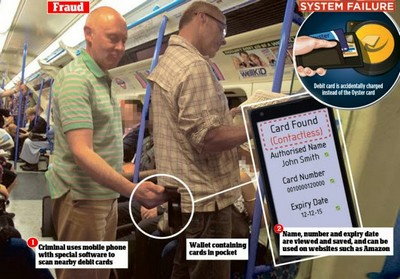
You don't have to worry. EMV is a chip standard that can have both contact and contactless interfaces. With the traditional contact interface, this means you actually have to physically insert the chip into a POS terminal for it to be authorized, like this:
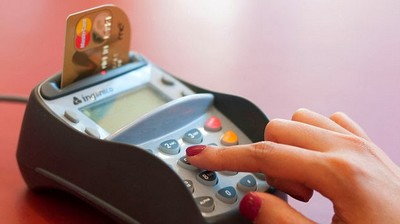
With the contact interface, nothing is wireless. No data is sent out in a stand-alone contact type EMV chip. With the EMV contactless interface, data is sent wirelessly.
Furthermore, contactless chip cards are required to show a symbol (looks like Wi-Fi symbol) somewhere on the card that to denote its capability as a contactless card. For example, here's an example of a Discover Card with contactless capability (in which Discover calls "Discover ZIP") showing the contactless symbol on the back of the card:
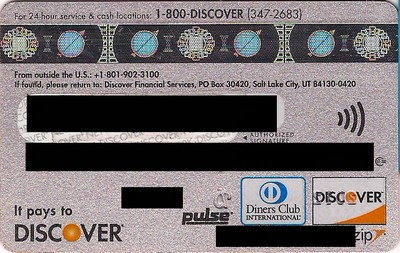
Don't believe everything that the media says. Besides, millions of people all over the world from London to Singapore, uses contactless payments daily in extremely crowded subways and mass transit with nary any problems. There are multiple layers of encrypted securities and keys that are needed to break the code.
Frankly, giving your physical card to a waiter/waitress who takes the card out of your view is much more susceptible to fraud than contactless payments.
Why should I care?
If you are an international traveler, you will want this because majority of the world has or in the process of converting to this payment format.
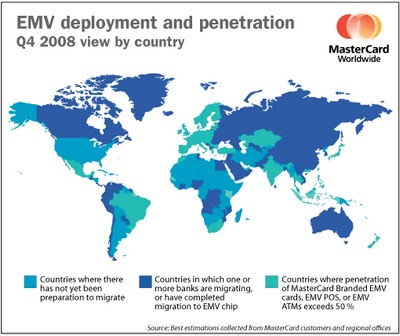
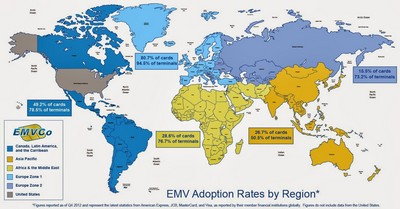
In fact, in 2012, even North Korea moved to the EMV format, leaving the US as one of the countries in the world that hasn't done so.
In addition, VISA, MC, AMEX, and Discover have all agreed to incentivize the USA shifting to EMV payments by 2015 by shifting liability for fraudulent transactions to merchants if they do not have EMV equipment and the cardholder has an EMV card. So if you travel internationally or would like to get one before the others, you might be interested in getting one.
BS! I had no problems using my card in [insert whereever country], [insert whatever point in time]
If you stick to the tourist path where they have lots of visitors from the US, you should have no problems using your mag-stripe only card in hotels and restaurants, at least for now. But as things can change as things go forward.
However, consider that once you start taking the off-beaten path, go to non-touristy places where they are not familiar with mag-stripes, rent a car and use toll roads, fill up gas, or try to buy train tickets you might end up into a trouble of the machine not recognizing your card because it lacks the chip. Furthermore, a lot of toll roads, gas pumps, and automated ticket machines lack any human assistance to help you when you need it the most.
But [insert credit card company] told me all merchants that display their logo must accept them! All I have to do is report them for violating their agreements, right?
There are several factors against this.
1. You can only speak English. The merchant representative, most likely a part-time clerk earning minimum wage, speaks in a different language, let's say French. If you have no French language skills, how are you going to get your point across? Are you going to whip out your cell phone at exorbitant int'l roaming charges and hope the customer service is going to translate it for you on the spot? Or maybe you might actually know French. But how about Swahili, Farsi, Balinese, or the multiple languages in mainland China?
2. Just like US, the rest of the world's businesses uses part-time minimum wage workers as cashiers to cut down on labor costs. Most of their SOP training manuals are written by MBA types to not to do anything they are not familiar with. Do not expect them to understand the intricate details of credit card mumbo jumbo. You don't expect Taco Bell employees to understand the minute details of Discover-JCB-Union Pay agreements, right? Same thing the other way around: be respectful as a guest in their country, prepare in advance in their ways, avoid being an "ugly American" stereotype.
3. You are a guest in their country. You are a minority. If 99.9% of their country's people and other tourists from around the world uses EMV, do you really think they are going to accomodate the 0.1% of American tourists who only have mag-stripes credit cards?
4. Again, you are a guest in their country. How would you, as an American standing in line, react if a Chinese tourist was clogging up the lines at a local Taco Bell because the clerk doesn't understand the Discover-Union Pay agreement and has trouble communicating between Mandarin spoken by the tourist and English spoken by the Taco Bell clerk? Same way the other way around. You do not want to clog up the lines for everyone. The less hassle, the better.
5. VISA and MC make tons of money from merchants in that country. Say SNCF French Rail. It's a billion dollar company in France. Do you think VISA is going to pull the plug of their relationship with SNCF because SNCF refuses to do mag-stripe processing at their unmanned train station kiosk? Of course not. Be realistic.
6. And lastly, if you're up against an unstaffed toll kiosk, gas pump or train ticket machine, are you going to yell curses at the machine?
But I want my credit card to be able to be used in the US too!
No worries. They have not gotten rid of the mag-stripe on the back of the card for backward compatibility reasons, just like we still have embossed numbers on our cards for backwards compatibility to using those old carbon copy imprinters.
[insert own Hyatt card image front and back together with red arrows pointing to all the backward compatibility features]
You use the chip on the front of the card abroad (for now), and the mag-stripe just like any other card for the US. Basically, you're increasing your credit card's acceptance rate by getting a card that both via the chip and the mag-stripe. You're getting a better deal for free.
And when 2015 comes along and US switches to EMV, you'll be way ahead of everyone else too!
So why did the rest of the world and the US moved/moving toward EMV?
Primarily, due to fraud concerns. You see, the mag-stripe has been with us since the 1950s. It may have been the most high tech thing back in the day, but with the technology that is available today, any shmo can pick up a $100 USB magnetic card skimming device off of eBay and get your credit card info.
And unlike skimming off contactless cards which actually need the person to have l33t programming skills, skimming off a magnetic stripe has become so ubiquitous that nary a day goes about skimming fraud going on somewhere in America, from gas pumps, Michael's stores (2011), Target breaches (2013), restaurant waiters/waitresses, to even McDonald's drive thrus.
https://www.google.com/search?q=skimming+fraud
These type of fraud used to be prevalent in Europe. But once they started switching over to EMV starting over 2 decades ago, this type of fraud went elsewhere. It went over to Asia, Canada and Mexico, Latin America, etc. etc. until they too began implementing EMV to combat skimming fraud. The US is practically the only country left that hasn't done so, therefore all the fraud that used to take place elsewhere is now happening here.
But EMV is old and it's not fool proof. Shouldn't we just skip over it and do something new instead?
Yes, EMV is old. It was developed in the 1990s, and its smart card payment predecessor was first introduced in France. But as of today, it has become the de-facto global standard of payments.
But then, what else is there? There is no other de facto global standard of payments alternative. For example, if we decide to skip over it and do something new, hypothetically like DNA matching technology, it still means US int'l travelers will continue to have problems abroad with useless plastic acceptance because no other country is using this DNA matching technology except the US.
Besides, nothing is fool proof. You can say that the bank vault isn't fool proof because you can crack it open if enough C4 is used. But your average low-life scumbag isn't likely to get military grade C4 easily either. But the bank vault does make it harder to get the bank's money over say a petty cash box. That's the point here. EMV is akin to a security tight bank vault, the old mag-stripe is akin to a petty cash box lying around inside the drawer.
I'm a business owner and I don't think EMV is going to take off. I'm not going to spend extra hundreds of dollars to upgrade my credit card machine. Convince me other wise why I should.
I can understand the added extra cost to your business once this switchover takes place. But before even saying that, look at your existing POS terminal. Does it have a slot somewhere to insert a card?
Most likely, if you had replaced your POS terminal within the past five years, you already have an EMV capable terminal. EMV is basically just not turned on yet from the processor and acquirer side.
If you have an EMV capable terminal, then a best bet would be to contact your acquirer to have the EMV feature turned on. You did your end of the deal already by having an EMV capable terminal, it is now the acquirers' responsibility to turn it on in accordance to the EMV switchover mandate.
And if you don't, you are going to replace your POS terminal anyway from common wear and tear. It isn't a hard switch-over. You can continue to use your POS terminal until it dies out because EMV cardholders will still have the mag-stripe on the back. And by the time your non-EMV capable POS terminal is up for replacement the market will be full with these newer POS terminals that can accept the mag-stripe, EMV, as well as contactless payments.
In addition, you may also want to check with your acquirer or processor about EMV capable terminals. Some of them are willing to replace your terminal for free in preparation for the US EMV switchover. Call and ask for details.
But what's in it for me? I'm the one that has to pay for the upgrade.
All the major card networks have given incentives for merchants for the upcoming EMV switchover.
If 75% or more of your credit card transactions are done on an EMV contact and contactless terminal, they are going to waive your annual PCI-DSS fees, which usually costs you around $5.00-$19.95/month per terminal. The overall long term cost savings of those compliance fees will be larger than the cost of an one time upgrade for the terminal.
The downside is that once EMV switchover happens and if you do not have a POS terminal that is able to accept EMV, the fraud liability shifts over to the merchant.
USA EMV cards: Availability, Q&A (Chip & PIN or Signature) [2017>]
#16
FlyerTalk Evangelist

Join Date: Jan 2014
Location: San Diego, CA
Programs: GE, Marriott Platinum
Posts: 15,602
AmEx were the ones saying to use your old PIN 3 times before the new one takes effect. SDFCU just mentioning to use signature if you change your PIN after converting your card over is more concerning since people won't know that they'll need to enter it incorrectly X number of times beforehand.
#17
Join Date: Jan 2015
Posts: 153
It is a bad advice for cards with a preferred PIN offline and the not zero offline limits.
The enter of new PIN x times (until PTC=0) guaranties the transaction will be completed online and issuer will send a script to update PIN on card.
The enter of new PIN x times (until PTC=0) guaranties the transaction will be completed online and issuer will send a script to update PIN on card.
Last edited by Lyolik; Jan 2, 2017 at 9:05 am
#18




Join Date: Aug 2008
Location: PHL
Programs: UA 1K 1MM, Marriott Gold, IHG Platinum, Raddison Platinum, Avis Presidents Club
Posts: 5,622
Please correct me if I'm interpreting wrong. I've been reading about card skimmers installed on ATM and other automated devices and people saying to use chip cards.
However, all chip cards (that I have), also have a magnetic strip. So a skimmer would still get my number. So although a chip transaction may be more secure, doesnt the card itself no more secure than before? (since it still has the strip)? And that's ignoring the fact that all the info is printed on the card anyways so one could take a picture.
I also read an article that the if a merchant switches to chip cards, any chip transaction is considered "secure" enough that now liability goes from the credit card to the merchant in cases of a fraud. If that is the case, isnt it likely that the reason for the credit cards pushing the chip technology is really to save money/liability and no so much improving security? They are still liable for non-chip transactions so maybe not.
It just seems that the use of the chips seems more hype than actual improved security. At least not improved security for the consumer in terms of someone stealing their number. Maybe improved security for the CC# on some transactions. Now someday if they remove the magnetic strips and all transactions are chip based, maybe that would be a different story.
However, all chip cards (that I have), also have a magnetic strip. So a skimmer would still get my number. So although a chip transaction may be more secure, doesnt the card itself no more secure than before? (since it still has the strip)? And that's ignoring the fact that all the info is printed on the card anyways so one could take a picture.
I also read an article that the if a merchant switches to chip cards, any chip transaction is considered "secure" enough that now liability goes from the credit card to the merchant in cases of a fraud. If that is the case, isnt it likely that the reason for the credit cards pushing the chip technology is really to save money/liability and no so much improving security? They are still liable for non-chip transactions so maybe not.
It just seems that the use of the chips seems more hype than actual improved security. At least not improved security for the consumer in terms of someone stealing their number. Maybe improved security for the CC# on some transactions. Now someday if they remove the magnetic strips and all transactions are chip based, maybe that would be a different story.
#19

Join Date: Oct 2014
Programs: Skymiles
Posts: 3,271
Please correct me if I'm interpreting wrong. I've been reading about card skimmers installed on ATM and other automated devices and people saying to use chip cards.
However, all chip cards (that I have), also have a magnetic strip. So a skimmer would still get my number. So although a chip transaction may be more secure, doesnt the card itself no more secure than before? (since it still has the strip)? And that's ignoring the fact that all the info is printed on the card anyways so one could take a picture.
I also read an article that the if a merchant switches to chip cards, any chip transaction is considered "secure" enough that now liability goes from the credit card to the merchant in cases of a fraud. If that is the case, isnt it likely that the reason for the credit cards pushing the chip technology is really to save money/liability and no so much improving security? They are still liable for non-chip transactions so maybe not.
It just seems that the use of the chips seems more hype than actual improved security. At least not improved security for the consumer in terms of someone stealing their number. Maybe improved security for the CC# on some transactions. Now someday if they remove the magnetic strips and all transactions are chip based, maybe that would be a different story.
However, all chip cards (that I have), also have a magnetic strip. So a skimmer would still get my number. So although a chip transaction may be more secure, doesnt the card itself no more secure than before? (since it still has the strip)? And that's ignoring the fact that all the info is printed on the card anyways so one could take a picture.
I also read an article that the if a merchant switches to chip cards, any chip transaction is considered "secure" enough that now liability goes from the credit card to the merchant in cases of a fraud. If that is the case, isnt it likely that the reason for the credit cards pushing the chip technology is really to save money/liability and no so much improving security? They are still liable for non-chip transactions so maybe not.
It just seems that the use of the chips seems more hype than actual improved security. At least not improved security for the consumer in terms of someone stealing their number. Maybe improved security for the CC# on some transactions. Now someday if they remove the magnetic strips and all transactions are chip based, maybe that would be a different story.
On card terminals in the store, the card is only dipped part way, which means a slimmer can't read the magnetic strip.
What makes a chip transaction itself more secure is the one time use token that isn't visible to you.
Also without the CVV they aren't doing much online shopping. And without your PIN- no ATM transactions either., so a picture of the card would render it useless.
Asp magnetic strip can't ever really go away, even in full chip countries. There's still many things that rely on it such as parking meters even in the U.K.
Last edited by RedLight2015; Jan 2, 2017 at 11:44 am
#20
FlyerTalk Evangelist

Join Date: Jan 2014
Location: San Diego, CA
Programs: GE, Marriott Platinum
Posts: 15,602
How likely is that in the US though? Even for overseas transactions US cards will still try to go online whenever possible, IIRC.
A lot more places than you'd expect don't ask for it (Amazon being the big one), so significant online shopping is still very much possible.
A lot more places than you'd expect don't ask for it (Amazon being the big one), so significant online shopping is still very much possible.
#22
FlyerTalk Evangelist

Join Date: Jan 2014
Location: San Diego, CA
Programs: GE, Marriott Platinum
Posts: 15,602
I just deleted and re-added one of my cards at Amazon and I wasn't asked for CVV at all. I even added something to my cart and started to go through the order process and wasn't asked either after selecting the card I just re-added.
#23
Join Date: Oct 2015
Location: Northern Virginia
Posts: 1,592
They also apparently support PINless debit, but it doesn't seem to work with my debit card, although it does with my Square Cash card. I believe they're using 3DS + initial CVV verification in countries like India, though.
#24




Join Date: Aug 2008
Location: PHL
Programs: UA 1K 1MM, Marriott Gold, IHG Platinum, Raddison Platinum, Avis Presidents Club
Posts: 5,622
A skimmer can't work if it can't reliably read the magstripe. On Chase ATMs, they has a manual dip reader, you can just insert the card really slow, leave it in and let it read the chip, and remove it really slow. - the same can be said for gas pumps.
On card terminals in the store, the card is only dipped part way, which means a slimmer can't read the magnetic strip.
What makes a chip transaction itself more secure is the one time use token that isn't visible to you.
Also without the CVV they aren't doing much online shopping. And without your PIN- no ATM transactions either., so a picture of the card would render it useless.
Asp magnetic strip can't ever really go away, even in full chip countries. There's still many things that rely on it such as parking meters even in the U.K.
On card terminals in the store, the card is only dipped part way, which means a slimmer can't read the magnetic strip.
What makes a chip transaction itself more secure is the one time use token that isn't visible to you.
Also without the CVV they aren't doing much online shopping. And without your PIN- no ATM transactions either., so a picture of the card would render it useless.
Asp magnetic strip can't ever really go away, even in full chip countries. There's still many things that rely on it such as parking meters even in the U.K.
There are many automated machines where your card slides all the way in. I agree, those ones where your card only goes in partway are probably safer. although most of your card is sticking out and you usually have to wait a while for it to process. Thats an excellent time for someone to take a photo of your phone while its in one place.
Although many places do ask for CVV, many do not.
Also, my United MPE card has the card number and the CVV both on the back so one can just take a photo. (Though in the case of above, all the info would be facing down so I guess more secure?
It just seems like the chip technology (may be a step in the right direction but) does not really improve things THAT much, or at least as much as the CC companies hype in their ads. I hope people arent lulled into a false sense of security.
On the other hand, as long as we still have $0 liability, who cares if someone steals our CC#. Yes there is some inconvenience but at least you arent out any money. I don't know about someone stealing a debit card number and taking the money in your bank account
#25
FlyerTalk Evangelist

Join Date: Jan 2014
Location: San Diego, CA
Programs: GE, Marriott Platinum
Posts: 15,602
By law the protections are supposed to be the same--if you report it to your bank/credit union early enough. In reality, you may have to fight them in certain cases (for instance, if you have the card run as debit with a PIN).
#26

Join Date: Oct 2014
Programs: Skymiles
Posts: 3,271
There are many automated machines where your card slides all the way in. I agree, those ones where your card only goes in partway are probably safer. although most of your card is sticking out and you usually have to wait a while for it to process. Thats an excellent time for someone to take a photo of your phone while its in one place.
Although many places do ask for CVV, many do not.
Also, my United MPE card has the card number and the CVV both on the back so one can just take a photo. (Though in the case of above, all the info would be facing down so I guess more secure?
It just seems like the chip technology (may be a step in the right direction but) does not really improve things THAT much, or at least as much as the CC companies hype in their ads. I hope people arent lulled into a false sense of security.
On the other hand, as long as we still have $0 liability, who cares if someone steals our CC#. Yes there is some inconvenience but at least you arent out any money. I don't know about someone stealing a debit card number and taking the money in your bank account
Although many places do ask for CVV, many do not.
Also, my United MPE card has the card number and the CVV both on the back so one can just take a photo. (Though in the case of above, all the info would be facing down so I guess more secure?
It just seems like the chip technology (may be a step in the right direction but) does not really improve things THAT much, or at least as much as the CC companies hype in their ads. I hope people arent lulled into a false sense of security.
On the other hand, as long as we still have $0 liability, who cares if someone steals our CC#. Yes there is some inconvenience but at least you arent out any money. I don't know about someone stealing a debit card number and taking the money in your bank account
And taking a picture in the reader? Europe etc has never complained about this but I suppose it can happen. What's worse and people should actually be concerned about is servers taking cards away from the table.
Last edited by RedLight2015; Jan 2, 2017 at 1:59 pm
#27




Join Date: Jul 2006
Location: SAN
Posts: 1,172
I have only now stumbled upon this and as far as I can tell this hasn't been answered. Having just received the replacement SDFCU card I can confirm that according to Cardpeek they basically swapped the signature and offline PIN CVM entries in the list. It used to be Online PIN (ATM)/Signature (CC)/Offline PIN (CC)/No verification (CC) and is now Online PIN (ATM)/Offline PIN (CC)/Signature (CC)/No verification (CC).
#28




Join Date: Aug 2008
Location: PHL
Programs: UA 1K 1MM, Marriott Gold, IHG Platinum, Raddison Platinum, Avis Presidents Club
Posts: 5,622
I also want to add that with the new EMV readers they'll go into "breach mode" if cracked open to install a skimmer in a gas pump. They will then HAVE to be sent in to be reencrypted, in order to function again. This alone will help the fuel pump skinning.
And taking a picture in the reader? Europe etc has never complained about this but I suppose it can happen. What's worse and people should actually be concerned about is servers taking cards away from the table.
And taking a picture in the reader? Europe etc has never complained about this but I suppose it can happen. What's worse and people should actually be concerned about is servers taking cards away from the table.
As for cracking open, I was referring to people that add some layer on top. I recall every ATM machine I used in Brazil had old glue near the slot opening like someone had previously glued something there.
I suppose I agree, this helps, but how much is yet to be seen.
However, as long as we have $0 liability, I'm pretty comfortable.
#29
Join Date: Oct 2015
Location: Northern Virginia
Posts: 1,592
I'm thinking about when I'm at the grocery store and stick my card in. To be honest, I don't remember how far the card goes in, maybe you can't really see the last 4 digits.
As for cracking open, I was referring to people that add some layer on top. I recall every ATM machine I used in Brazil had old glue near the slot opening like someone had previously glued something there.
I suppose I agree, this helps, but how much is yet to be seen.
However, as long as we have $0 liability, I'm pretty comfortable.
As for cracking open, I was referring to people that add some layer on top. I recall every ATM machine I used in Brazil had old glue near the slot opening like someone had previously glued something there.
I suppose I agree, this helps, but how much is yet to be seen.
However, as long as we have $0 liability, I'm pretty comfortable.
#30

Join Date: Oct 2014
Programs: Skymiles
Posts: 3,271
I'm thinking about when I'm at the grocery store and stick my card in. To be honest, I don't remember how far the card goes in, maybe you can't really see the last 4 digits.
As for cracking open, I was referring to people that add some layer on top. I recall every ATM machine I used in Brazil had old glue near the slot opening like someone had previously glued something there.
I suppose I agree, this helps, but how much is yet to be seen.
However, as long as we have $0 liability, I'm pretty comfortable.
As for cracking open, I was referring to people that add some layer on top. I recall every ATM machine I used in Brazil had old glue near the slot opening like someone had previously glued something there.
I suppose I agree, this helps, but how much is yet to be seen.
However, as long as we have $0 liability, I'm pretty comfortable.













